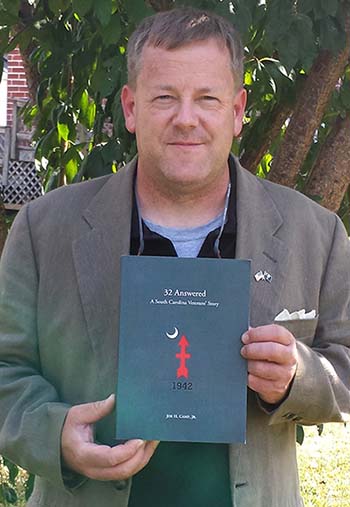 In "32 Answered: A South Carolina Veterans' Story," 1988 Lander graduate Dr. Joe H. Camp, Jr. brings to life the incredible story of how 32 Army Reserve officers from South Carolina delivered the first punch to the Japanese Empire in the Pacific theater during WWII.
In "32 Answered: A South Carolina Veterans' Story," 1988 Lander graduate Dr. Joe H. Camp, Jr. brings to life the incredible story of how 32 Army Reserve officers from South Carolina delivered the first punch to the Japanese Empire in the Pacific theater during WWII.
Ironically, the soldiers from South Carolina made their mark as members of the 32nd Infantry Division, also known as the Red Arrow Division, originally composed of the Michigan and Wisconsin National Guard units.
"Shortly after the Japanese attacked Pearl Harbor, the U.S. Army purged the officer ranks of the Michigan and Wisconsin Guard regiments of those who were deemed to be 'over-age in grade' or otherwise unfit for combat. Many of those vacancies were then filled with ROTC cadets from the four prewar ROTC programs in South Carolina," explained Camp.
The cadets came from Clemson A&M College, The Citadel, Presbyterian College and Wofford College.
"The Division was put together on the fly, characteristic of the ad hoc expediency and chaotic times in early 1942 during the rushed mass-mobilization, and was assigned to garrison duty for defense of Australia, and placed under the command of General Douglas MacArthur," said Camp.
"The Red Arrows had their first engagement with a battle-hardened Japanese force in the jungles of Papua New Guinea," Camp continued. "Even though they sustained casualty rates of over 90 percent, the Red Arrows were the first army unit to defeat the Japanese on land."
The men who survived that first tragic and defining battle at Buna stayed with the unit, and emerged to form the core of officer leadership for later campaigns and continued serving through the end of the war. In fact, the Red Arrows were still fighting well past V-J Day and even accepted the surrender party of Japanese General Yamashita in the Philippines the same morning that the peace treaty ceremony was taking place miles away on the battleship Missouri in Tokyo Bay.
Out of the original 32 soldiers from South Carolina, five did not return home alive.
In researching material for "32 Answered: A South Carolina Veterans' Story," Camp relied upon myriad sources, including diaries, letters and first-person memoirs of the participants.
"The children of the veterans were the most important sources of information," said Camp. "Because their experiences were so traumatic, the veterans shared very little of what happened with their families. But many families did keep correspondence and belongings."
While no one family was able to provide an absolutely complete picture of the experiences of the soldiers of the Red Arrows, Camp was able to cross reference artifacts from multiple families with official records. Were it not for Camp's historical research methodology, the story of the Red Arrows may have been lost to the fading memories of the remaining surviving veterans.
One reviewer of "32 Answered: A South Carolina Veterans' Story," wrote, "The Southern officers were undoubtedly heroes without the deserved notoriety until this book; it is well-written and extremely well-researched."
Writing to Camp, one family member of a Red Arrow veteran said, "We didn't ask enough questions of our fathers about their experiences. It's a blessing to us all that you've filled in the blanks for us to rediscover what had been lost."